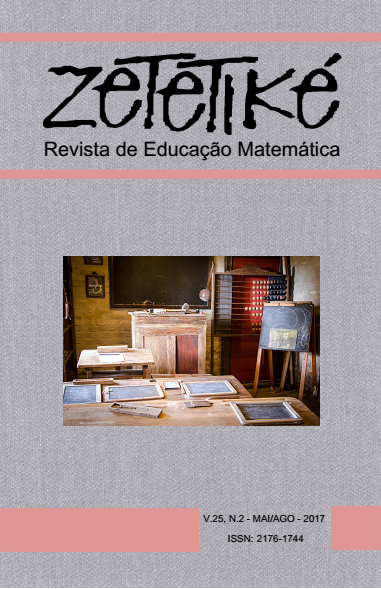Abstract
The main goal of this study is to verify the contribution that representations give to the learning of the derivate
of a function by 11th grade students. Adopting a qualitative and interpretative approach, the data was collected
through the students’ resolution of tasks. The results indicate that, in spite generalized use of the algebraic
representation, the numerical, the tabular, and the graphic representations were also used. The numerical and
algebraic representations were used essentially to determine the image of a given object, in particular, in the
case of relative extremes. The graphic representation was used to compare a function with its derivate function
or whenever the students wanted a global image of the function behaviour. The tabular representation was used
essentially to study the monotony and the relative extremes of a function and, in some cases, in the conversion
between the algebraic and the graphic representation.
References
Aires, A., & Vazquez, M. (2004). O conceito de derivada no ensino secundário ao longo do século XX. In Atas do Encontro sobre o tema História do Ensino da Matemática em Portugal (pp. 101-120). Lisboa: Sociedade portuguesa de investigação em educação matemática.
Almeida, C., & Viseu, F. (2002). Interpretação gráfica das derivadas de uma função por professores estagiários de Matemática. Revista Portuguesa de Educação, 15(1), 193-219.
Azcárate, G., C., Casadevall, M., Casellas, E., & Bosch, D. (1996). Cálculo diferencial e integral. Madrid: Sintesis.
Bogdan, R., & Biklen, S. (1994). Investigação Qualitativa em Educação. Porto: Porto Editora.
Brown, S. A., & Mehilos, M. (2010). Using tables to Bridge Arithmetic and Algebra. Mathematics Teaching in the Middle School, 15(9), 532-538.
Dick, T. P. (1996). Much more than a toy. Graphing calculators in secondary school calculus. In P. Gomez & B. Waits (Eds.), Roles of Calculators in the Classroom (pp. 31-46).
Dreyfus, T. (2002). Advanced mathematical thinking processes. In D. Tall (Ed.). Advanced mathematical thinking (pp. 25-41). Dordrecht. Kluwer Academic Publisher.
Duval, R. (2012). Registros de representação semiótica e funcionamento cognitivo do pensamento. REVEMAT, 7(2), 266-297.
Ferrini-Mundy, J., & Lauten, D. (1994). Learning about calculus learning. The Mathematics Teacher, 87(2), 115-121.
Friedlander, A., & Tabach, M. (2001). Promoting multiple representations in algebra. In A. A. Cuoco, & F. R. Curcio (Eds), The roles of representation in school mathematics (pp. 173-185). Reston: VA: NCTM.
Gagatsis, A., & Elia, I. (2004). The effects of diferente modes of representation on mathematical problema solving. In Proceedings of the 28th Conference of the International Group for the Psychology of Mathematics Education, 2, pp. 4447-454.
García, A. (2000). Nuevas tecnologías y enseñanza de las matemáticas. Madrid: Síntesis.
Giraldo, V., Carvalho, L., & Tall, D. (2003). Descriptions and definitions in the teaching of elementary calculus. In N. A. Pateman, B.J. Dougherty, & J. Zilliox (Eds.), Proceedings of the 27th Conference of the International Group for the Psychology of Mathematics Education, vol. 2, pp. 445–452.
Goldenberg, E. (1988). Mathematics, metaphors, and human factors: Mathematical, technical, and pedagogical challenges in the educational use of graphical representation of functions. Journal of Mathematical Behavior, 7, 135-173.
Goldin, G. A. (2002). Representation in mathematical learning and problem solving. In L. D. English (Ed.), Handbook of International Research in Mathematics Education (pp. 197-278). Mahwah, New Jersey: Lawrence Erlbaum Associates.
Janvier, C. (1987). Representation and understanding: The notion of function as an example. In C. Janvier (Ed.), Problems of representation in the teaching and learning of mathematics (pp. 67-72). Hillsdale, New Jersey. Lawrence Erlbaum Associates, Publishers.
Kaput, J. (1992). Technology and mathematics education. In D. Grouws (Ed.). Handbook of Research on Mathematics Teaching and Learning (pp. 515-556). New York: Macmillan.
Leinhardt, G., Zaslavsky, O., & Stein, M. (1990). Functions, graphs, and graphing: Tasks, learning and teaching. Review of Educational Research, 60(1), 1-64.
Ministério da Educação e Ciência (2014). Programa e Metas Curriculares Matemática A. Lisboa: Autor.
NCTM (2008). Princípios e Normas para a Matemática Escolar. Lisboa: APM.
Ponte, J., & Canavarro, A. (1997). Matemática e Novas Tecnologias. Lisboa: Universidade Aberta.
Ruthven, K. (1993). Personal Technology and Classroom Change: A British Perspective. In J. T. Fey (Ed.), Calculators in mathematics education (pp. 91-100). Reston: National Council of Teachers of Mathematics. (Yearbook 1992).
Tall, D. (1994). Computer environments for the learning of mathematics. In R. Biehler, R. W. Scholz, R. Sträßer & B. Winkelmann (Eds.), Didactics of mathematics as a scientific discipline (pp. 189-199). Dordrecht: Kluwer Academic Publisher.
Tall, D. (2002). The psychology of advanced mathematical thinking. In D. Tall (Ed.). Advanced mathematical thinking (pp. 3-21). Dordrecht. Kluwer Academic Publisher.
Teixeira, P., Precatado, A., Albuquerque, C., Antunes, C., & Nápoles, S. M. (1998). Matemática: funções - 11º ano de escolaridade. Lisboa: Ministério da Educação, Departamento do Ensino Secundário.
Vinner, S. (1983). Conflicts between definitions and intuitions: the case of the tangent. In Proceedings of the 6th PME Conference, Antwerp. (pp. 24-28).
Vinner, S. (1989). The avoidance of visual considerations in calculus students. In T. Eisenberg & T. Dreyfus (Eds.), Focus on Learning Problems in Mathematics, 11(2), 149-156.
Vinner, S. (2002). The role of definitions in the teaching and learning of mathematics. In D. Tall (Ed.). Advanced mathematical thinking (pp. 65-81). Dordrecht. Kluwer Academic Publisher.

This work is licensed under a Creative Commons Attribution-NonCommercial-NoDerivatives 4.0 International License.
Copyright (c) 2017 Zetetike


